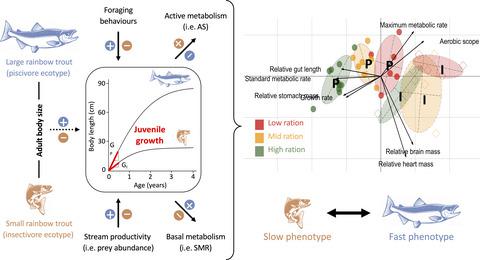当前位置:
X-MOL 学术
›
J. Anim. Ecol.
›
论文详情
Our official English website, www.x-mol.net, welcomes your feedback! (Note: you will need to create a separate account there.)
Adaptive differentiation of growth, energetics and behaviour between piscivore and insectivore juvenile rainbow trout ( O. mykiss ) along the Pace‐of‐Life continuum
Journal of Animal Ecology ( IF 4.8 ) Pub Date : 2020-10-12 , DOI: 10.1111/1365-2656.13326 Gauthier Monnet 1 , Jordan S Rosenfeld 2, 3 , Jeffrey G Richards 1
Journal of Animal Ecology ( IF 4.8 ) Pub Date : 2020-10-12 , DOI: 10.1111/1365-2656.13326 Gauthier Monnet 1 , Jordan S Rosenfeld 2, 3 , Jeffrey G Richards 1
Affiliation

|
Adaptive trade-offs are fundamental mechanisms underlying phenotypic diversity, but the presence of generalizable patterns in multivariate adaptation and their mapping onto environmental gradients remain unclear. To understand how life-history affects multivariate trait associations, we examined relationships among growth, metabolism, anatomy and behaviour in rainbow trout juveniles from piscivore vs. insectivore ecotypes along an experimental gradient of food availability. We hypothesized that i) selection for larger size in piscivorous adults would select for higher juvenile growth at the cost of lower active metabolism; ii) elevated growth of piscivores would be supported by a greater productivity of their natal stream and more proactive foraging behaviours; and iii) general patterns of multivariate trait associations would match the predictions of the Pace-Of-Life Syndrome. Relative to insectivores, piscivorous fry showed a pattern of higher growth (+63%), maximum food intake (+33%), growth efficiency (+41%), and standard metabolic rate (SMR; +47%), but lower active metabolic capacity (maximum metabolic rate (MMR; -17%), aerobic scope (AS; -48%)), suggesting that faster piscivore growth is supported by greater food intake and digestive capacity but is traded-off against lower scope for active metabolism. A similar trade-off appeared among organ systems, with piscivorous fry exhibiting an 83% greater investment in average mass of organs associated with food consumption and processing (i.e. stomach and intestine), but an apparently smaller relative investment in organs involved in cardio-vascular or cognitive activities (heart and brain, respectively). Higher invertebrate drift in their natal rearing habitat, quicker behavioural transition to a novel food source and lower anxiety after a frightening event in piscivorous fry suggest that faster growth requires both proactive foraging behaviours and higher prey availability in the environment. Finally, the sampling of replicate insectivore populations confirmed their lower juvenile growth (-73% on average) and reduced environmental productivity of their natal streams (-45% lower drift abundance) relative to the piscivore ecotype. Our results suggest that selection for large adult body size influences selection on high juvenile growth, high basal metabolism and proactive behaviours, and that the intense phenotypic divergence between piscivorous and insectivorous rainbow trout may be constrained by environmental productivity.
中文翻译:

生活节奏连续体中食鱼和食虫的虹鳟幼鱼(O. mykiss)的生长、能量和行为的适应性分化
适应性权衡是表型多样性背后的基本机制,但多元适应中可概括模式的存在及其对环境梯度的映射仍不清楚。为了了解生活史如何影响多元性状关联,我们沿着食物供应的实验梯度检查了来自食鱼动物和食虫动物生态型的虹鳟鱼幼鱼的生长、新陈代谢、解剖结构和行为之间的关系。我们假设 i) 选择较大体型的食鱼成鱼会以较低的活跃代谢为代价选择较高的幼鱼生长;ii) 食鱼动物的快速增长将得到其出生流的更高生产力和更积极的觅食行为的支持;iii) 多元特征关联的一般模式将与生活节奏综合症的预测相匹配。相对于食虫动物,食鱼鱼苗表现出较高的生长 (+63%)、最大食物摄入量 (+33%)、生长效率 (+41%) 和标准代谢率 (SMR;+47%),但活性较低代谢能力(最大代谢率(MMR;-17%),有氧范围(AS;-48%)),表明更大的食物摄入量和消化能力支持更快的食鱼动物生长,但与较低的活跃代谢范围进行权衡. 器官系统之间也出现了类似的权衡,食鱼鱼苗在与食物消费和加工相关的器官(即胃和肠)的平均质量上的投资增加了 83%,但对涉及心血管或认知活动的器官(分别为心脏和大脑)的相对投资明显较小。在它们出生的饲养栖息地中更高的无脊椎动物漂移、更快的行为过渡到新的食物来源以及在鱼苗发生可怕事件后更低的焦虑表明更快的生长需要主动的觅食行为和环境中更高的猎物可用性。最后,与食虫动物生态型相比,重复食虫种群的抽样证实了它们的幼鱼生长较低(平均 -73%)和其出生流的环境生产力降低(漂移丰度较低 -45%)。我们的研究结果表明,对成年体型较大的选择会影响对幼鱼的高生长、高基础代谢和主动行为的选择,
更新日期:2020-10-12
中文翻译:

生活节奏连续体中食鱼和食虫的虹鳟幼鱼(O. mykiss)的生长、能量和行为的适应性分化
适应性权衡是表型多样性背后的基本机制,但多元适应中可概括模式的存在及其对环境梯度的映射仍不清楚。为了了解生活史如何影响多元性状关联,我们沿着食物供应的实验梯度检查了来自食鱼动物和食虫动物生态型的虹鳟鱼幼鱼的生长、新陈代谢、解剖结构和行为之间的关系。我们假设 i) 选择较大体型的食鱼成鱼会以较低的活跃代谢为代价选择较高的幼鱼生长;ii) 食鱼动物的快速增长将得到其出生流的更高生产力和更积极的觅食行为的支持;iii) 多元特征关联的一般模式将与生活节奏综合症的预测相匹配。相对于食虫动物,食鱼鱼苗表现出较高的生长 (+63%)、最大食物摄入量 (+33%)、生长效率 (+41%) 和标准代谢率 (SMR;+47%),但活性较低代谢能力(最大代谢率(MMR;-17%),有氧范围(AS;-48%)),表明更大的食物摄入量和消化能力支持更快的食鱼动物生长,但与较低的活跃代谢范围进行权衡. 器官系统之间也出现了类似的权衡,食鱼鱼苗在与食物消费和加工相关的器官(即胃和肠)的平均质量上的投资增加了 83%,但对涉及心血管或认知活动的器官(分别为心脏和大脑)的相对投资明显较小。在它们出生的饲养栖息地中更高的无脊椎动物漂移、更快的行为过渡到新的食物来源以及在鱼苗发生可怕事件后更低的焦虑表明更快的生长需要主动的觅食行为和环境中更高的猎物可用性。最后,与食虫动物生态型相比,重复食虫种群的抽样证实了它们的幼鱼生长较低(平均 -73%)和其出生流的环境生产力降低(漂移丰度较低 -45%)。我们的研究结果表明,对成年体型较大的选择会影响对幼鱼的高生长、高基础代谢和主动行为的选择,


























 京公网安备 11010802027423号
京公网安备 11010802027423号